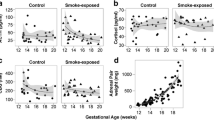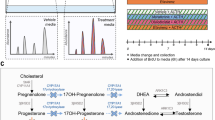Abstract
Objective
To examine the secretory effect of prostaglandin E2 (PGE2) and ACTH on the adrenal glands of prenatal and postnatal sheep.
Methods
Immunocytochemistry was used to examine the adrenal cortex and medulla for 17α-hydroxylase and tyrosine hydroxylase immunoreactivity. Microphysiometric technique was used to measure [H+] after exposure of whole dispersed prenatal and postnatal adrenal glands to PGE2, ACTH, or both.
Results
Immunocytochemistry showed many cortical-type cells in all adrenal medullae and many medullary-type cells in fetal adrenal cortices. Maximum H+ responsiveness to PGE2 deceased with increasing age. The developmental age-related pattern of maximum percentage change in [H+] during ACTH exposure was similar to previous findings with cortisol production as the endpoint. ACTH stimulated H+ production at 80 days’ gestation and at all ages greater than 125 days’ gestation (P <. 05). The molar concentration of ligand required to elicit a response that was 50% of maximum response (EC50) for the ACTH response was lower in fetuses than in newborn lambs (< 1 day and 3 days old), but there was no change in EC50 for PGE2 across the ages studied. Adrenal cell response to ACTH after prior ACTH and PGE2 exposure was higher (P <. 05) compared with ACTH after ACTH or ACTH alone at 110 days’ gestation only and was lower in 3-day-old lambs.
Conclusions
Based on the ACTH results, microphysiometry was a valid method for investigating dispresed adrenal cell physiology. Prostaglandin E2 stimulated dispersed adrenal cells during the mid-gestation ACTH refractory period, but this effect decreased with increasing age. Prostaglandin E2 sensitized adrenal cells to ACTH at 110 days’ gestation but inhibited ACTH effects at postnatal day 3.
Similar content being viewed by others
References
Mann SE, Nijland MJ, Ross MG. Fetal absorption of intra-amniotic aldosterone: Effects on urine composition. J Soc Gynecol Investig 1999;6:252–7.
Benson CA, Wintour EM. The effect of bilateral fetal adrenalectomy on fluid balance in the ovine fetus. J Physiol (Lond) 1995;489(Pt 1):235–41.
Liggins GC. Adrenocortical-related maturational events in the fetus. Am J Obstet Gynecol 1976;126:931–41.
Liggins GC, Fairclough RJ, Grieves SA, Kendall JZ, Knox BS. The mechanism of initiation of parturition in the ewe. Rec Prog Horm Res 1973;29:111–59.
Challis JRG, Brooks AN. Maturation and activation of hypotha-lamic-pituitary-adrenal function in fetal sheep. Endocrine Rev 1989;10:182–204.
Lewis AB, Evans WN, Sischo W. Plasma catecholamine responses to hypoxemia in fetal lambs. Biol Neonate 1982;41:115–22.
Paulick R, Kastendieck E, Weth B, Wernze H. Metabolic, cardiovascular and sympathoadrenal reactions of the fetus to progressive hypoxia—animal experiment studies. Z Geburtshilfe Perinatol 1987;191:130–9.
Cheung CY. Fetal adrenal medulla catecholamine response to hypoxia-direct and neural components. Am J Physiol 1990;258:R1340–6.
Thorburn GD. The placenta, prostaglandins and parturition: A review. Reprod Fertil Dev 1991;3:277–94.
Liggins GC, Scroop GC, Haughey KG. Comparison of the effects of prostaglandin E2, prostacyclin and 1-24 adrenocorticotrophin on plasma Cortisol levels of fetal sheep. J Endocrinol 1982;95:153–62.
Comline RS, Silver M. Development of activity in the adrenal medulla of the foetus and new-born animal. Br Med Bull 1966;22:16–20.
Comline RS, Silver M. The release of adrenaline and noradrenaline from the adrenal glands of the foetal sheep. J Physiol 1961;156:424–44.
Hooper SB, Coulter CL, Deayton JM, Harding R, Thorburn GD. Fetal endocrine responses to prolonged hypoxemia in sheep. Am J Physiol 1990;259:R703–8.
Karaplis AC, Powell WS. Prostaglandin E-binding sites in the fetal adrenal. Endocrinology 1981;109:2124–8.
Ajilore O, Sapolsky RM. Application of silicon microphysiometry to tissue slices: Detection of metabolic correlates of selective vulnerability. Brain Research 1997;752:99–106.
Chio CL, Lajiness ME, Huff RM. Activation of heterologously expressed D3 dopamine receptors: Comparison with D2 dopamine receptors. Mol Pharmacol 1994;45:51–60.
McConnell HM, Owicki JC, Parce JW, et al. The cytosensor microphysiometer: Biological applications of silicon technology. Science 1992;257:1906–12.
Owicki JC, Parce JW. Bioassays with a microphysiometer. Nature 1990;344:271
Owicki JC, Parce JW. Biosensors based on the energy metabolism of living cells: The physical chemistry and cell biology of extracellular acidification. Biosens Bioelectron 1992;7:255–72.
Owicki JC, Parce JW, Kercso KM, et al. Continuous monitoring of receptor-mediated changes in the metabolic rates of living cells. Proc Natl Acad Sci U S A 1990;87:4007–11.
Owicki JC, Bousse LJ, Hafeman DG, et al. The light-addressable potentiometric sensor: Principles and biological applications. Annu Rev Biophys Biomol Struct 1994;23:87–113.
Parce JW, Owicki JC, Kercso KM. Biosensors for directly measuring cell affecting agents. Ann Biol Clin (Paris) 1990;48:639–41.
Pitchford S, De Moor K, Glaeser BS. Nerve growth factor stimulates rapid metabolic responses in PC 12 cells. Am J Physiol 1995;268:C936–43.
Watson RE, Wiegand SJ, Clough RW, Hoffman GE. Use of cryoprotectant to maintain long-term peptide immunoreactivity and tissue morphology. Peptides 1986;7:155–9.
Hoffman GE, McDonald TJ, Figueroa JP, Nathanielsz PW. Neuropeptide cells and fibers in the hypothalamus and pituitary of the fetal Sheep: Comparison of oxytocin and arginine vasopressin. Neuroendocrinology 1989;50:633–43.
Bornstein SR, Ehrhart-Bornstein M, Scherbaum WA, Pfeiffer EF, Holst JJ. Effects of splanchnic nerve stimulation on the adrenal cortex may be mediated by chromaffin cells in a paracrine manner. Endocrinology 1990;127:900–6.
Walker SW, Lightly ERL, Milner SW, Williams BC. Catecholamine stimulation of Cortisol secretion by 3-day primary cultures of purified fasciculata/reticularis cells isolated from bovine adrenal cortex. Mol Cell Endocrinol 1988;57:139–47.
Pohorecky LA, Wurtman RJ. Adrenocortical control of epinephrine synthesis. Pharmacol Rev 1971;23:1–35.
Walker SW, Lightly ER, Clyne C, Williams BC, Bird IM. Adrenergic and cholinergic regulation of Cortisol secretion from the zona fasciculata/reticularis of bovine adrenal cortex. Endocr Res 1991;17:237–65.
Haidan A, Bornstein SR, Glasow A, et al. Basal steroidogenic activity of adrenocortical cells is increased 10-fold by coculture with chromaffin cells. Endocrinology 1998;139:772–80.
Bornstein SR, Gonzalez-Hernandez JA, Ehrhart-Bornstein M, Alder G, Scherbaum WA. Intimate contact of chromaffin and cortical cells within the human adrenal gland forms the cellular basis for important intraadrenal interactions. J Clin Endocrinol Metab 1994;78:225–32.
Bornstein SR, Ehrhart-Bornstein M. Ultrastructural evidence for a paracrine regulation of the rat adrenal cortex mediated by the local release of catecholamines from chromaffin cells. Endocrinology 1992;131:3126–8.
Gallo-Payet N, Pothier P, Isler H. On the presence of chromaffin cells in the adrenal cortex: Their possible role in adrenocortical function. Biochem Cell Biol 1987;65:588–92.
Cheung CY. Enhancement of adrenomedullary catecholamine release by adrenal cortex in fetus. Am J Physiol 1984;247:693–7.
Graham ADM, Cheung L, Cheung CY. Catecholamine secretion from the adrenal medulla of the fetus, regulation by hormones. J Dev Physiol 1986;8:227–35.
Hinson JP. Paracrine control of adrenocortical function: A new role for the medulla? J Endocrinol 1990;124:7–9.
Pohorecky LA, Wurtman RJ. Adrenocortical control of epinephrine synthesis. Pharmacological reviews 1971;23:1–35.
Wintour EM, Brown EH, Denton DA, et al. The ontogeny and regulation of corticosteroid secretion by the ovine foetal adrenal. Acta Endocrinol 1975;79:301–16.
Durand P. ACTH receptor levels in lamb adrenals at late gestation and early neonatal stages. Biol Reprod 1979;20:837–45.
Coulter CL, Myers DA, Nathanielsz PW, Bird IM. Ontogeny of angiotensin II type 1 receptor and cytochrome P450(cl1) in the sheep adrenal gland. Biol Reprod 2000;62:714–9.
Bird IM, Lightly ER, Nicol M, Williams BC, Walker SW. Dopaminergic stimulation of Cortisol secretion from bovine zfr cells occurs through nonspecific stimulation of adrenergic beta-receptors. Endocr Res 1998;24:769–72.
Roebuck MM, Jones CT, Holland D, Silman R. In vitro effects of high molecular weight forms of ACTH on the fetal sheep adrenal. Nature 1980;284:616–8.
Norman LJ, Lye SJ, Wlodek ME, Challis JRG. Changes in pituitary responses to synthetic ovine corticotrophin releasing factor in fetal sheep. Can J Physiol Pharmacol 1985;63:1398–403.
Krozowski Z. The 11 beta-hydroxysteroid dehydrogenases: Functions and physiological effects. Mol Cell Endocrinol 1999;151:121–7.
Berghorn KA, Li C, Nathanielsz PW, McDonald TJ. VIP innervation: Sharp contrast in fetal sheep and baboon adrenal glands suggests differences in developmental regulation. Brain Res 2000;877:271–80.
Ma XH, Wu WX, Nathanielsz P. Characterization of mRNA for prostaglandin (PG) E2 receptor subtypes in ovine fetal hippocampus (HC), hypothalamus (HT), pituitary (P) gland and adrenal. J Soc Gynecol Investig 1998;5:154A.
Koyama Y, Kitayama S, Dohi T, Tsujimoto A. Evidence that prostaglandins activate calcium channels to enhance basal and stimulation-evoked catecholamine release from bovine adrenal chromaffin cells in culture. Biochem Pharmacol 1988;37:1725–30.
Gutman Y, Boonyaviroj P. Mechanism of PGE inhibition of catecholamine release from adrenal medulla. Eur J Pharmacol 1979;55:129–36.
Karaplis AC, Funk CD, Powell WS. Binding of prostaglandin E2 to cultured bovine adrenal chromaffin cells and its effect on catecholamine secretion. Biochim Biophys Acta 1989;1010:369–76.
Liggins GC. The role of Cortisol in preparing the fetus for birth. Reprod Fertil Dev 1994;6:141–50.
Author information
Authors and Affiliations
Corresponding author
Additional information
Supported by National Institutes of Health grant HD 21350, DK51234-02 and Consejo Nacional de Ciencia y Tecnología (CONACyT) México Fellowship.
Rights and permissions
About this article
Cite this article
Zambrano, E., Nathanielsz, P.W. & McDonald, T.J. Prenatal and Postnatal Ovine Adrenal Cell responses to Prostaglandin E2. Reprod. Sci. 8, 149–157 (2001). https://doi.org/10.1177/107155760100800305
Published:
Issue Date:
DOI: https://doi.org/10.1177/107155760100800305




